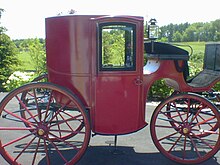A brougham[a] is a 19th century four-wheeled carriage drawn by a single horse. It was named after the politician and jurist Lord Brougham, who had this type of carriage built to his specification by London coachbuilder Robinson & Cook in 1838.




Description
editThe brougham has an enclosed body with two doors and sits two passengers; there are two fold-away seats in the front corners for small children. It has a box seat in front for a coachman plus one footman or passenger. The carriage body has a front window so that the passengers can see forward. The carriage is mounted on elliptical springs with small front wheels which can go under the carriage to turn sharply.[3][4][5]: 23 [6]: 49–50 [b]
Features specific to the brougham include:[3]
- the absence of a perch (a supporting pole connecting the front and rear axles); the spring hangers were mounted directly to the body structure, saving weight and lowering the floor, to ease entry
- a sharply squared end of the roof at the back,
- a body line curving forward at the base of the enclosure, and
- low entry to the enclosure, using only one outside step below the door.
A variant, called a brougham-landaulet, has a top collapsible from the rear doors backward.
In literature
editBroughams are a common means of transport in the Sherlock Holmes stories.
The Picture of Dorian Gray by Oscar Wilde mentions the brougham alongside a number of other carriage vehicles of the era, such as the omnibus, the hansom cab, the four-in-hand, and the victoria.
In L. P. Hartley's novel The Go Between a brougham is sent to fetch the character Marian (chapter 23, p.274 [1st ed.]).
In the book The Alienist by Caleb Carr, a frequently used mode of transportation for the characters is a brougham.
In Rudyard Kipling's poem "The Mary Gloster", the dying Sir Anthony complains bitterly to his son about never seeing "the doctor's trusty brougham to help the missus unload" – a reference to the effete Dickie's childless marriage and hence the extinction of his family.
In the novel The Crimson Petal and the White, by Michel Faber, William Rackham purchases a brougham as a surprise gift for his wife, Agnes Rackham, with the help of his beautiful mistress, a former prostitute known as Sugar.
See also
edit- Coupé (carriage): any type of four-wheeled coach where two passengers sit on a forward-facing bench
- Brougham (car body), inspired by the brougham carriage
- Clarence (carriage), larger version of the Brougham
- Carriage
- Horse-drawn vehicle
Notes
edit- ^ Pronounced /ˈbru(ə)m/ BROO-əm or /ˈbroʊ(ə)m/ BROH-əm.[2]
- ^ The OED gives a first usage in 1851, but the original design dates from about 1838, according to the Encyclopædia Britannica. Brougham died in 1868.
References
edit- ^ "Prototype of the Brougham carriage". London Science Museum. Retrieved 23 August 2024.
- ^ "brougham". Oxford English Dictionary (Online ed.). Oxford University Press. (Subscription or participating institution membership required.)
- ^ a b Haajanen, Lennart W. (2007). Illustrated Dictionary of Automobile Body Styles. McFarland & Company. pp. 24–25. ISBN 9780786437375. LCCN 2002014546. OL 9550033M.
- ^ Stratton, Ezra (1878). World on Wheels. New York: Bloom. p. 376. ISBN 0-405-09006-4. OL 7004294M. Retrieved 4 September 2014.
- ^ Smith, D.J.M. (1988). A Dictionary of Horse Drawn Vehicles. J. A. Allen & Co. Ltd. ISBN 0851314686. OL 11597864M.
- ^ Walrond, Sallie (1979). The Encyclopaedia of Driving. Country Life Books. ISBN 0600331822. OL 4175648M.
External links
edit- 1871 Advertisement for William Kilross & Sons and Kinross Brougham Illustrations and text
- CAAOnline: Carriage Tour Carriage Association of America. Illustration and text
- Horse Drawn Brougham, The Henry Ford. Henry Ford Museum, Dearborn, Michigan. Photo and text.
- The Long Island Museum of American Art, History & Carriages, Stony Brook, New York: Collection Database. Search brougham; illustrations and text.
- Victorian Brougham carriage and The Victorian Brougham at the Institute of Texan Cultures TTM web. Texas Transportation Museum, San Antonio. Photos
- Articles about Horse-drawn Carriages